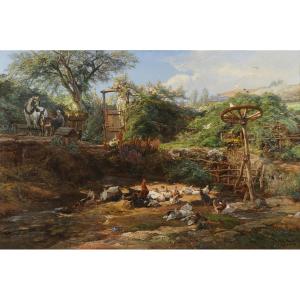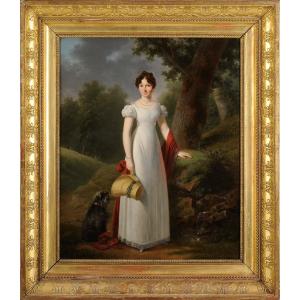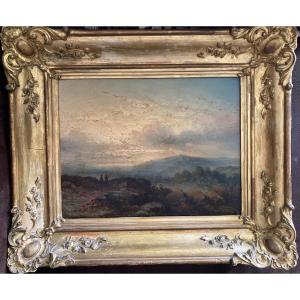(Lyon, 1812 - Lyon, 1885)
Landscape of the surroundings of Lyon
Oil on canvas
H. 40 cm; W. 55 cm
Signed lower left
Provenance:
- Offered in a Lyon lottery by the artist (handwritten inscription on the back)
- Villart Collection, Lyon
- Paris Art Market around 1990
- Private collection, Toronto, Canada
Ponthus-Cinier belongs to what could be defined as the third (and so to speak last) generation of neo-classical or historical landscapers, born in the 1810s/1820s, such as Félix Lanoüe, Achille Bénouville, Paul Flandrin, Eugène Ferdinand Buttura and Alfred de Curzon. More particularly, he is considered the main and most popular representative of the landscapers of the Lyon school around the middle of the 19th century. Of a generous, honest personality, and pleasant company, Ponthus-Cinier came from a family of merchants on his mother's side and magistrates on his father's side; destined for commerce by his parents, he preferred the artistic path, and after enrolling at the Lyon School of Fine Arts in 1829, and training in Paris with Paul Delaroche, he exhibited his first works at the Lyon Salon of 1839, before participating in the Paris Salon in 1841. That same year, he received the second Prix de Rome for historical landscape (won by Buttura in 1837, and Bénouville in 1845), beaten by the Versaillais Lanoüe. To improve his skills, Ponthus-Cinier then decided to go to Italy, alone and at his own expense, for a single stay between 1842 and 1844; he discovered the Ligurian coast, Tuscany, Naples, and of course Rome and its surroundings, and executed a considerable quantity of studies (painted sketches or pen sketches) which he used to compose views of Italy throughout his career. Ponthus-Cinier's main qualities probably lie in "the art of illuminating a canvas" as A. Jouve wrote in the 19th century, and in his sense of perspective, sometimes truly extraordinary; he seems, however, most of the time, a little less brilliant in the figures and in the transcription of details.
Our canvas offered by the artist to a Lyon lottery during his lifetime, as he was in the habit of doing, remained in Lyon until the end of the last century before reaching Toronto and returning from there. The stone bridge spanning this stream and its lock seem to be a French subject from the Lyon area, as the artist was able to represent them. The composition, framed by two wooded areas, opens in several shots onto this bridge which becomes the subject of the work.




































 Le Magazine de PROANTIC
Le Magazine de PROANTIC TRÉSORS Magazine
TRÉSORS Magazine Rivista Artiquariato
Rivista Artiquariato